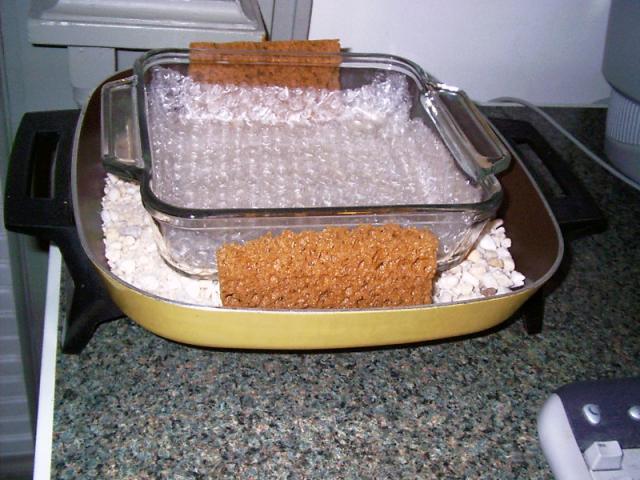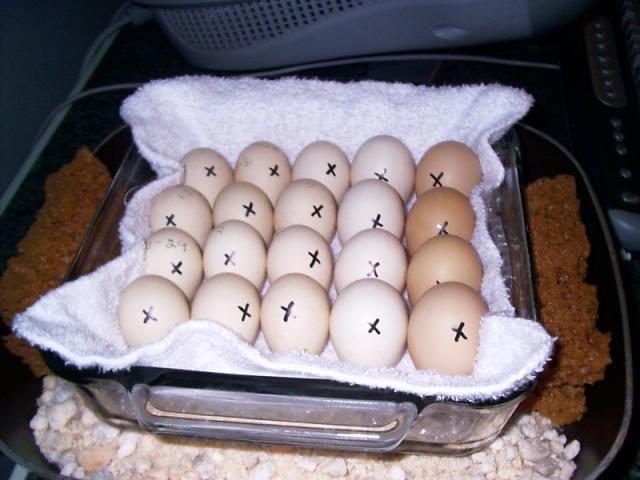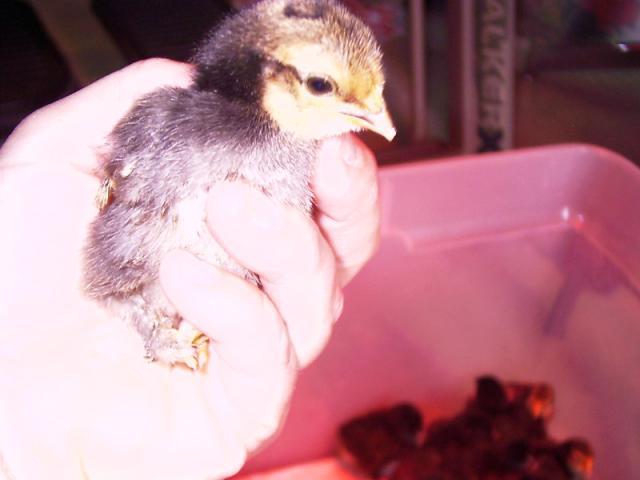Hi everyone! I have had many requests for how to make Bunny's Pan-O-Bator, so I thought I'd post the information in my blog.
I was determined to build a homemade incubator, and my DH and I built 2 different incubators when I first started raising poultry. Both of them worked, but I had a lot of problems with keeping the temperatures regulated, and also problems with the humidity.
One day I was at the local Goodwill and I spotted an old harvest gold, square, GE Electric Skillet, with a lid that was vented. The pan was in great shape and the cord was like brand new. Just for an experiment, I bought it for 6.00 and took it home to make a simple incubator. I used my own cochin eggs for the first test hatch, instead of ordering expensive hatching eggs. ( I bought expensive eggs for the first two trys and lost most of them)

1. It has a thermostat control and a vent on top. I put 1/4 inch of clean playground sand in the bottom of the pan. This serves to hold and radiate heat evenly. This setup will not work without the sand!
2. I added and 8x8 glass pyrex brownie pan on top of the sand. I put a small piece of bubble wrap in the pyrex dish and a dry washcloth on top of the bubble wrap for my "nest". It serves well for cusioning and absorbency.
3. I had a digitial meat thermometer in the kitchen drawer, and I stuck the probe through one of the vent holes in the lid.
4. I cut up a sea sponge into 4 pieces and wet it and squeezed out all the excess water. (you don't want steam to form on the lid and drip onto your eggs)
Hint: you will have some steam to form from time to time, but it doesn't hurt the eggs unless they are soaking wet for an extended period.)
Also, buy some Jello in the snack packs, and punch a tiny hole in the top of the lid. Put your thermometer probe into the jello, through the vent lid. This will give you a fairly accurate temperature reading. Just remember that the Jello and the inside of the egg can safely be 106 degrees F. The liquid is warmer that the air inside the incubator. I try to keep the temperature, between 99 F and 103 F. I have tried to hatch chicks at a lower temperature, but I believe it causes problems. Room temperature fluctuations will cause your pan to come on, so try to keep it in a room that is a steady temperature. If the room gets cold, your pan will stay on and possible get too hot. If the room is too warm your pan won't come on and the eggs might get a bit cool. So, you have to keep a close eye on them until you get the hang of it. Don't worry if you have a few temperature spikes or lows, the eggs can take temperatures up to 108 F (Jello Temperature) Just adjust the knob on the thermostat and place a piece of tape over the knob. (This keeps children, grandchildren and others from inadvertently cooking your eggs!)
5. Here is the tricky part. Before you set your eggs place your Jello cup into the pan and adjust your thermostat until you have about 100 degrees F steady for a couple of hours. Then mark your eggs and add them to the "nest". It can take approximately 24 to 48 hours to regulate the temps. Don't worry though, it won't harm the embryos. I have personally had temperature spikes of 110, and I fixed it with no harm done to the eggs. Just take the lid off of this happens and let them cool off a few minutes. Your eggs shoud be fine as long as any extremes are not for an extended period of time.
6. Your pan will hold about 16 eggs. You can see that I squeezed 20 eggs into the pan, but they are Cochin Bantam and Mille Fleur eggs.
(Pan setup) (Set the eggs) (Cover and Thermometer) (Mille Fleur)




Tips:
I used my own eggs, from my hens to test the incubator.
In my first two incubators I installed a small computer fan. I think it dried the eggs out too much. (I don't think a hen has a fan on her butt!)
I turn my eggs 3-5 times each day and keep the sponges moist, but not wet.
I usually candle the eggs on days 10, and again on day 17. I get rid of the duds and quitters.
I usually up the moisture a little on the last three days and keep the temps as steady as possible, no lower than 101 F.
I take the chicks out after they are moving around and ready to be placed in the brooder box. I put them under a heat lamp with a thermometer, to let them dry out and get on their feet. I don't offer them water until the second day, unless I have some unusually thirsty and active chicks. Use your own judgement on this.
I have 2 of these now. My Dad found a similar pan that has a taller lid, but is made the same way. It works the same way.
I was determined to build a homemade incubator, and my DH and I built 2 different incubators when I first started raising poultry. Both of them worked, but I had a lot of problems with keeping the temperatures regulated, and also problems with the humidity.
One day I was at the local Goodwill and I spotted an old harvest gold, square, GE Electric Skillet, with a lid that was vented. The pan was in great shape and the cord was like brand new. Just for an experiment, I bought it for 6.00 and took it home to make a simple incubator. I used my own cochin eggs for the first test hatch, instead of ordering expensive hatching eggs. ( I bought expensive eggs for the first two trys and lost most of them)

1. It has a thermostat control and a vent on top. I put 1/4 inch of clean playground sand in the bottom of the pan. This serves to hold and radiate heat evenly. This setup will not work without the sand!
2. I added and 8x8 glass pyrex brownie pan on top of the sand. I put a small piece of bubble wrap in the pyrex dish and a dry washcloth on top of the bubble wrap for my "nest". It serves well for cusioning and absorbency.
3. I had a digitial meat thermometer in the kitchen drawer, and I stuck the probe through one of the vent holes in the lid.
4. I cut up a sea sponge into 4 pieces and wet it and squeezed out all the excess water. (you don't want steam to form on the lid and drip onto your eggs)
Hint: you will have some steam to form from time to time, but it doesn't hurt the eggs unless they are soaking wet for an extended period.)
Also, buy some Jello in the snack packs, and punch a tiny hole in the top of the lid. Put your thermometer probe into the jello, through the vent lid. This will give you a fairly accurate temperature reading. Just remember that the Jello and the inside of the egg can safely be 106 degrees F. The liquid is warmer that the air inside the incubator. I try to keep the temperature, between 99 F and 103 F. I have tried to hatch chicks at a lower temperature, but I believe it causes problems. Room temperature fluctuations will cause your pan to come on, so try to keep it in a room that is a steady temperature. If the room gets cold, your pan will stay on and possible get too hot. If the room is too warm your pan won't come on and the eggs might get a bit cool. So, you have to keep a close eye on them until you get the hang of it. Don't worry if you have a few temperature spikes or lows, the eggs can take temperatures up to 108 F (Jello Temperature) Just adjust the knob on the thermostat and place a piece of tape over the knob. (This keeps children, grandchildren and others from inadvertently cooking your eggs!)
5. Here is the tricky part. Before you set your eggs place your Jello cup into the pan and adjust your thermostat until you have about 100 degrees F steady for a couple of hours. Then mark your eggs and add them to the "nest". It can take approximately 24 to 48 hours to regulate the temps. Don't worry though, it won't harm the embryos. I have personally had temperature spikes of 110, and I fixed it with no harm done to the eggs. Just take the lid off of this happens and let them cool off a few minutes. Your eggs shoud be fine as long as any extremes are not for an extended period of time.
6. Your pan will hold about 16 eggs. You can see that I squeezed 20 eggs into the pan, but they are Cochin Bantam and Mille Fleur eggs.
(Pan setup) (Set the eggs) (Cover and Thermometer) (Mille Fleur)




Tips:
I used my own eggs, from my hens to test the incubator.
In my first two incubators I installed a small computer fan. I think it dried the eggs out too much. (I don't think a hen has a fan on her butt!)
I turn my eggs 3-5 times each day and keep the sponges moist, but not wet.
I usually candle the eggs on days 10, and again on day 17. I get rid of the duds and quitters.
I usually up the moisture a little on the last three days and keep the temps as steady as possible, no lower than 101 F.
I take the chicks out after they are moving around and ready to be placed in the brooder box. I put them under a heat lamp with a thermometer, to let them dry out and get on their feet. I don't offer them water until the second day, unless I have some unusually thirsty and active chicks. Use your own judgement on this.
I have 2 of these now. My Dad found a similar pan that has a taller lid, but is made the same way. It works the same way.
